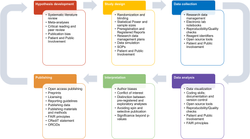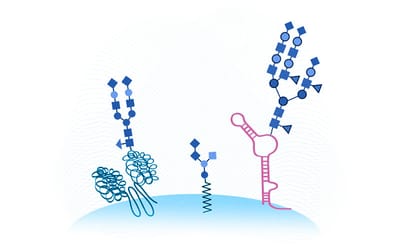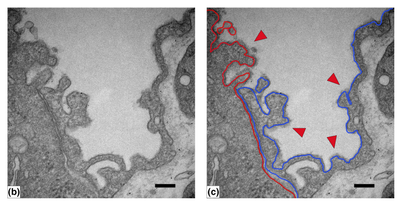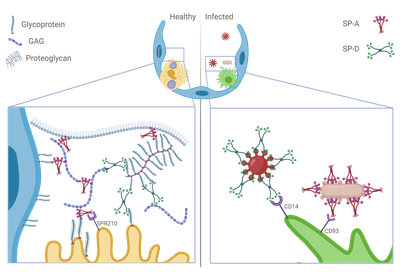Timm, S., Lettau, M., Hegermann, J., Rocha, M.L., Weidenfeld, S., Fatykhova, D., Gutbier, B., Nouailles, G., Lopez-Rodriguez, E., Hocke, A., Hippenstiel, S., Witzenrath, M., Kuebler, W.M., Ochs, M.: Histochem Cell Biol. 2023;160(2):83-96.
To access the full article, click here:

Recent investigations analyzed in depth the biochemical and biophysical properties of the endothelial glycocalyx. In comparison, this complex cell-covering structure is largely understudied in alveolar epithelial cells. To better characterize the alveolar glycocalyx ultrastructure, unaffected versus injured human lung tissue explants and mouse lungs were analyzed by transmission electron microscopy. Lung tissue was treated with either heparinase (HEP), known to shed glycocalyx components, or pneumolysin (PLY), the exotoxin of Streptococcus pneumoniae not investigated for structural glycocalyx effects so far. Cationic colloidal thorium dioxide (cThO2) particles were used for glycocalyx glycosaminoglycan visualization. The level of cThO2 particles orthogonal to apical cell membranes (≙ stained glycosaminoglycan height) of alveolar epithelial type I (AEI) and type II (AEII) cells was stereologically measured. In addition, cThO2 particle density was studied by dual-axis electron tomography (≙ stained glycosaminoglycan density in three dimensions). For untreated samples, the average cThO2 particle level was ≈ 18 nm for human AEI, ≈ 17 nm for mouse AEI, ≈ 44 nm for human AEII and ≈ 35 nm for mouse AEII. Both treatments, HEP and PLY, resulted in a significant reduction of cThO2 particle levels on human and mouse AEI and AEII. Moreover, a HEP- and PLY-associated reduction in cThO2 particle density was observed. The present study provides quantitative data on the differential glycocalyx distribution on AEI and AEII based on cThO2 and demonstrates alveolar glycocalyx shedding in response to HEP or PLY resulting in a structural reduction in both glycosaminoglycan height and density. Future studies should elucidate the underlying alveolar epithelial cell type-specific distribution of glycocalyx subcomponents for better functional understanding.








